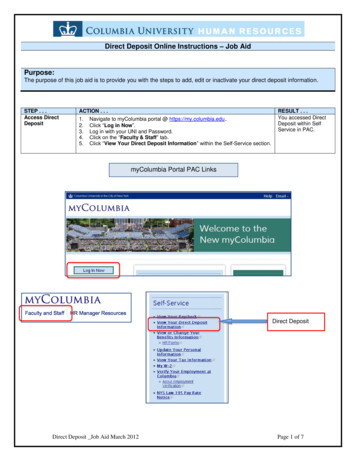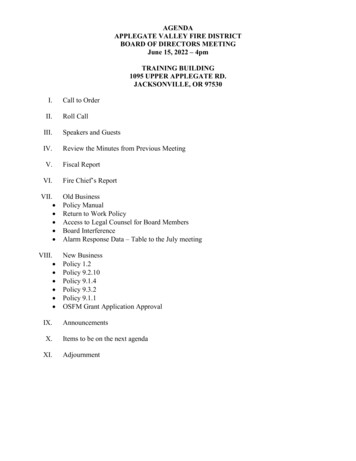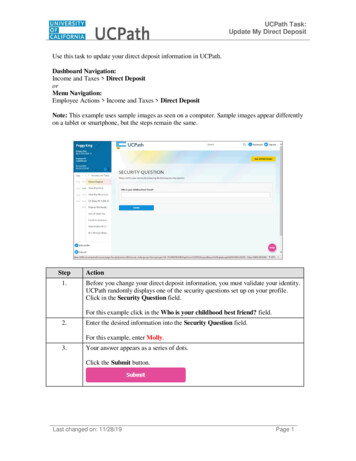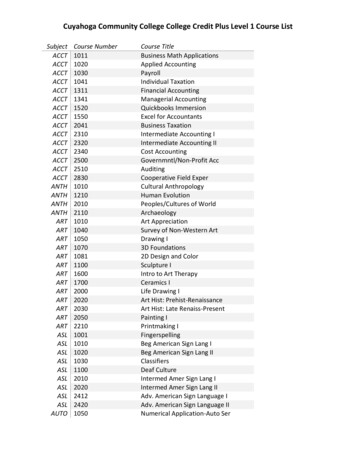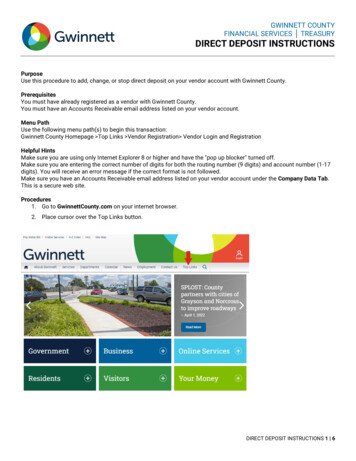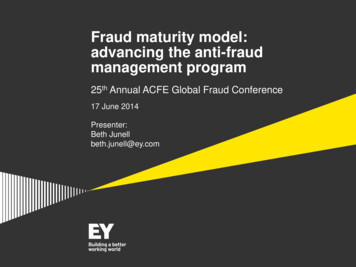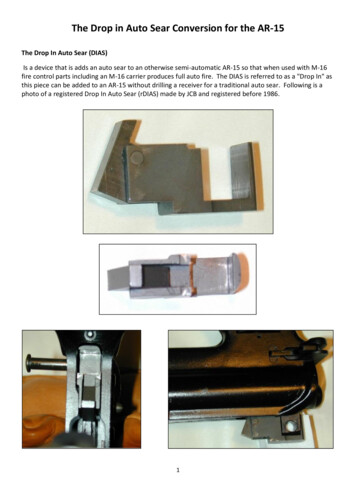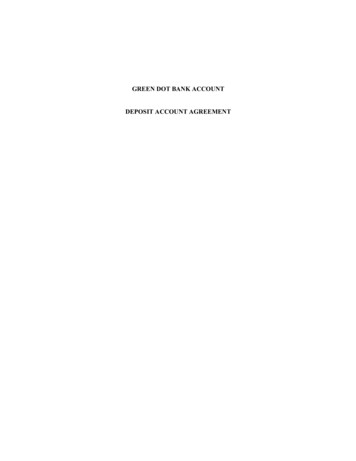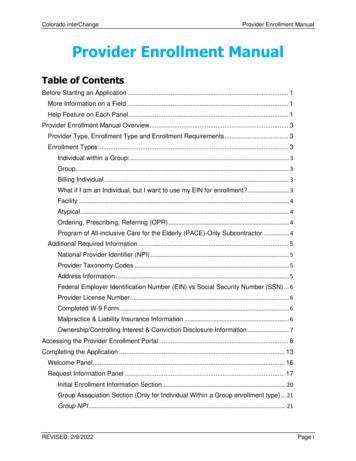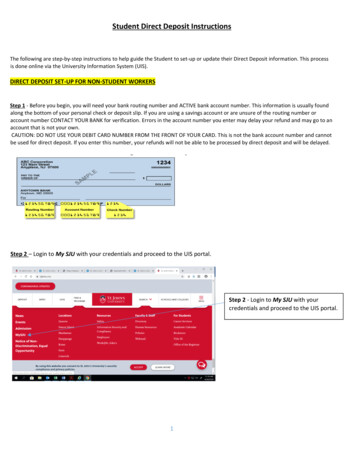
Transcription
Audit ReportDirect Deposit Auto-EnrollmentFraud Prevention BlockA-06-14-14042 April 2015
MEMORANDUMDate:April 22, 2015Refer To:To:The CommissionerFrom:Inspector GeneralSubject:Direct Deposit Auto-Enrollment Fraud Prevention Block (A-06-14-14042)The attached final report presents the results of our audit. Our objective was to determinewhether the Social Security Administration’s Direct Deposit Auto-Enrollment Fraud Preventionblock worked as intended and prevented benefit payment diversion.If you wish to discuss the final report, please call me or have your staff contactSteven L. Schaeffer, Assistant Inspector General for Audit, at (410) 965-9700.Patrick P. O’Carroll, Jr.Attachment
Direct Deposit Auto-Enrollment Fraud Prevention BlockA-06-14-14042April 2015Office of Audit Report SummaryObjectiveFindingsTo determine whether the SocialSecurity Administration’s (SSA)Direct Deposit Auto-Enrollment FraudPrevention (DDFP) block worked asintended and prevented benefitpayment diversion.The DDFP block worked as intended and reduced the risk of directdeposit fraud for those who used the block. We reviewed bankaccount change activity and reports of benefit non-receipt forapproximately 38,000 beneficiaries with DDFP blocks on theiraccounts. We did not identify any instances where there was anauto-enrollment account change and a subsequent report of nonreceipt of benefits after SSA placed a DDFP block on abeneficiary’s record. We identified a small number of cases wherefraudsters successfully diverted benefit payments through meansother than auto-enrollment after SSA added the block to thebeneficiaries’ records. However, SSA was proactive in takingaction to prevent similar errors from occurring in the future.BackgroundMost Social Security beneficiaries arerequired to receive their paymentsthrough direct deposit rather than paperchecks. Beneficiaries have a variety ofmethods available to change theirdirect deposit account information:they can call or visit an SSA office,call SSA’s 800-number, use SSA’sWebsite, or contact their financialinstitution (auto-enrollment).Unauthorized direct deposit changescan occur when a perpetrator obtainsenough personally identifiableinformation to redirect a payment fromthe beneficiary’s account into anaccount they control.To protect beneficiaries fromunauthorized account changes, inNovember 2012, SSA introduced theDDFP block. Beneficiaries or theirrepresentative payees may request aDDFP block because of alleged fraudor as a preventive measure.As of September 2014, SSA hadestablished fraud blocks onapproximately 120,000 beneficiaries’records.Beneficiaries we interviewed who had been victims of identityfraud before SSA added the block on their records were generallysatisfied with the block and believed it was effective and worked asintended.We made no recommendations for corrective action.
TABLE OF CONTENTSObjective .1Background .1Results of Review .2Beneficiaries Generally Satisfied with the DDFP Block .2Conclusions .3Agency Comments .3Appendix A – Scope and Methodology . A-1Appendix B – Agency Comments . B-1Appendix C – Major Contributors. C-1Direct Deposit Auto-Enrollment Fraud Prevention Block (A-06-14-14042)
ABBREVIATIONSC.F.R.Code of Federal RegulationsDDFPDirect Deposit Auto-Enrollment Fraud PreventionOIGOffice of the Inspector GeneralSSASocial Security AdministrationDirect Deposit Auto-Enrollment Fraud Prevention Block (A-06-14-14042)
OBJECTIVEOur objective was to determine whether the Social Security Administration’s (SSA) DirectDeposit Auto-Enrollment Fraud Prevention (DDFP) block worked as intended and preventedbenefit payment diversion.BACKGROUNDMost Social Security beneficiaries are required to receive their payments through direct depositrather than paper checks. 1 SSA beneficiaries have a variety of methods available to change theirdirect deposit account information. Beneficiaries can call or visit an SSA office, call SSA’s800-number, visit SSA’s Website, 2 or contact their financial institution (auto-enrollment) tochange their direct deposit account information.Unauthorized direct deposit changes can occur when a perpetrator obtains enough personallyidentifiable information to redirect an SSA payment from the beneficiary’s account into anaccount they control. When this occurs, beneficiaries typically report the non-receipt of benefitsto SSA. In October 2011, we began tracking allegations of unauthorized direct deposit changes.As of May 20, 2013, we had received over 36,000 reports of an unauthorized change orsuspected attempt to make an unauthorized change to a beneficiary’s record.To protect beneficiaries from unauthorized account changes, in November 2012, SSA introducedthe DDFP block. As of September 2014, SSA had established fraud blocks on approximately120,000 beneficiaries’ records. Beneficiaries or their representative payees may request a DDFPblock because of alleged fraud or as a preventive measure. If they want to change their accountinformation, they may be required to visit a field office to request the change. 3 Once SSAactivates a DDFP block on an individual’s record, it may only be removed with the beneficiaryor representative payee’s authorization. When introduced, the DDFP block prevented changesrequested through auto-enrollment. In August 2013, SSA updated the block to also preventdirect deposit and address changes requested through its my Social Security Website. Theblock does not prevent changes requested through SSA’s field offices.SSA’s Office of Systems provided fraud block data as of July 2013 for our audit. At that time,SSA had established DDFP blocks on about 38,000 beneficiaries’ records. For additionalinformation on our scope and methodology, see Appendix A.131 C.F.R. § 208.3. See 31 C.F.R. § 208.4 for waivers to this requirement.SSA introduced my Social Security in May 2012 and made direct deposit information changes available throughmy Social Security as of January 2013.23After placement of the DDFP block on a Social Security record, SSA policy states the beneficiary or representativepayee may be required to go into the field office for direct deposit and address changes.Direct Deposit Auto-Enrollment Fraud Prevention Block (A-06-14-14042)1
RESULTS OF REVIEWThe DDFP block worked as intended and reduced the risk of direct deposit fraud for those whoused the block. We reviewed bank account change activity and reports of benefit non-receipt forapproximately 38,000 beneficiaries with DDFP blocks on their accounts. We did not identifyany instances of an auto-enrollment account change and subsequent report of non-receipt ofbenefits after SSA placed a DDFP block on a beneficiary’s record. However, we identified24 instances where fraudsters successfully diverted benefit payments through means other thanauto-enrollment after SSA added the block to the beneficiaries’ records. In 11 cases, SSA records indicated that personnel processed account changes after fraudsterswho had knowledge of the beneficiaries’ personally identifiable information contacted SSAposing as the beneficiary and requested the account changes. After SSA was informed ofthese diversions, staff placed special messages on the beneficiaries’ payment recordsindicating that future account changes must be conducted in person.In 11 cases, SSA records indicated fraudsters used my Social Security to divert thebeneficiaries’ payments before SSA modified the DDFP block to prevent account changesthrough my Social Security in August 2013.In two cases, SSA employees failed to change bank account information after beneficiariesreported fraudsters had diverted their benefits. In both cases, SSA employees added fraudblocks on the accounts to prevent future diversions. However, employees did not change thedeposit account information back to the beneficiaries’ correct account. As a result, SSAdeposited three additional benefit payments into accounts established by the fraudsters.Although every benefit diversion case can significantly impact the beneficiary, we areencouraged that only a small number of diversions occurred after SSA placed the blocks on theseaccounts and that SSA had taken action to prevent future diversions.Beneficiaries Generally Satisfied with the DDFP BlockWe interviewed 12 beneficiaries in the Dallas, Texas, and Denver, Colorado, metropolitan areaswho had been victims of identity fraud before SSA added the DDFP block to their records. 4Eleven were satisfied with the fraud block and stated the block was effective and worked asintended.One beneficiary reported that the DDFP block did not prevent a fraudster from redirecting hisbenefits. In this case, a fraudster posing as an insurance salesman visited the beneficiary in hishome. Believing he was purchasing insurance, the beneficiary provided the “salesman” hispersonal information, including his Social Security number. After the visit, the beneficiarycalled the insurance company to speak with the “salesman,” but the company informed him the4Appendix A provides additional information on interviewee selection.Direct Deposit Auto-Enrollment Fraud Prevention Block (A-06-14-14042)2
individual was not an employee. Realizing he was a victim of a scam, the beneficiary contactedan SSA field office and a DDFP block was placed on his record. Despite the DDFP block, SSArecords indicated the fraudster used the beneficiary’s personally identifiable information to makeaccount changes via my Social Security. This diversion occurred before my Social Securitychanges were added to the DDFP block in August 2013.CONCLUSIONSThe DDFP block worked as intended and reduced the risk of direct deposit fraud for those whoused the block. We reviewed bank account change activity and reports of benefit non-receipt forapproximately 38,000 beneficiaries with DDFP blocks on their accounts. We did not identifyany instances of an auto-enrollment account change and subsequent report of non-receipt ofbenefits after SSA placed a DDFP block on a beneficiary’s record. We identified a smallnumber of cases where fraudsters successfully diverted benefit payments through means otherthan auto-enrollment after SSA added the block to the beneficiaries’ records. In these cases,SSA was proactive in taking action to prevent similar diversions from occurring in the future.We made no recommendations for corrective action.AGENCY COMMENTSThe Agency’s comments are included in Appendix B.Direct Deposit Auto-Enrollment Fraud Prevention Block (A-06-14-14042)3
APPENDICESDirect Deposit Auto-Enrollment Fraud Prevention Block (A-06-14-14042)
Appendix A – SCOPE AND METHODOLOGYTo accomplish our objectives we: Reviewed prior Social Security Administration (SSA) Office of the Inspector General reportsconcerning direct deposit fraud. Direct Deposit Changes Initiated by the Social Security Administration’s National800-Number Staff (A-02-12-21272), July 10, 2012. Direct Deposit Changes Initiated Through Financial Institutions and the Social SecurityAdministration’s Internet and Automated 800-Number Applications (A-14-12-21271),December 20, 2012. Controls over the Enrollment Process with the Direct Express Debit Card Program(A-15-12-21273), December 21, 2012. Controls over Direct Deposit Changes Initiated in Field Offices (A-06-12-22101),January 23, 2013. Non-receipt of Social Security Benefits Due to Unauthorized Direct Deposit Changes(A-02-13-23004), May 13, 2014. Interviewed SSA officials to gain an understanding of the Direct Deposit Auto-EnrollmentFraud Prevention (DDFP) block. Reviewed SSA policies and procedures referencing the DDFP block. Obtained a listing from SSA’s Office of Systems of 37,852 beneficiaries whose recordscontained a DDFP block as of July 29, 2013. Obtained data from SSA’s Master Benefit Record, Payment History Update System, andAudit Trail System for each of the 37,852 beneficiaries. Identified 1,104 beneficiaries whose records showed a report of non-receipt of benefits afterSSA placed the DDFP block. SSA records for 526 beneficiaries indicated no bank change occurred between the timeSSA established the fraud block and the beneficiary reported the non-receipt. Weexcluded these cases from further review. For the remaining 578 cases, we reviewed transaction dates for fraud block placement, direct deposit account changes,and reports of non-receipt;Direct Deposit Auto-Enrollment Fraud Prevention Block (A-06-14-14042)A-1
reviewed the special message posted on the Master Beneficiary Record for evidenceof post-fraud block benefit diversion; reviewed the source of the bank account changes with transaction dates after fraudblock placement dates; and interviewed 12 of the 15 beneficiaries who resided within an approximately 100-mileradius of SSA’s Regional Offices in Dallas, Texas, and Denver, Colorado. 1 All12 individuals had been victims of identity fraud before SSA placed the fraud blockon their SSA records.We conducted our audit in Dallas, Texas, from April to November 2014. We tested the dataobtained for our audit and determined them to be sufficiently reliable to meet our objective. Theentities audited were the Offices of Operations and Systems. We conducted this performanceaudit in accordance with generally accepted government auditing standards. Those standardsrequire that we plan and perform the audit to obtain sufficient, appropriate evidence to provide areasonable basis for our findings and conclusions based on our audit objective. We believe theevidence obtained provides a reasonable basis for our findings and conclusions based on ouraudit objective.1Three beneficiaries in the Dallas, Texas metropolitan area did not respond to letters, multiple telephone calls, or avisit to their address of record. According to SSA records, one individual died in December 2014. We referred theremaining two cases to the Dallas Region for development.Direct Deposit Auto-Enrollment Fraud Prevention Block (A-06-14-14042)A-2
Appendix B – AGENCY COMMENTSSOCIAL SECURITYMEMORANDUMDate:April 9, 2015To:Patrick P. O’Carroll, Jr.Inspector GeneralFrom:Frank Cristaudo /s/Executive Counselor to the CommissionerSubject:Office of the Inspector General Draft Report, “Direct Deposit Auto-Enrollment Fraud PreventionBlock” (A-06-14-14042) - INFORMATIONRefer To:S1J-3Thank you for the opportunity to review the draft report. Please see our attached comments.Please let me know if we can be of further assistance. You may direct staff inquiries toGary S. Hatcher at (410) 965-0680.AttachmentDirect Deposit Auto-Enrollment Fraud Prevention Block (A-06-14-14042)B-1
COMMENTS ON THE OFFICE OF THE INSPECTOR GENERAL (OIG) DRAFTREPORT, “DIRECT DEPOSIT AUTO-ENROLLMENT FRAUD PREVENTIONBLOCK” (A-06-14-14042)General CommentsWe appreciate OIG conducting this review and endorsing our position that the Direct DepositAuto-Enrollment Fraud Prevention Block works as intended. In addition, OIG confirmed ourtechnicians and the public have successfully embraced the application. We are confident that theuse of the Direct Deposit Auto-Enrollment Fraud Prevention (DDFP) block will continue to beeffective; both our customers and we are already realizing the DDFP block’s benefits.We are committed to expanding our efforts to reduce the instances of unauthorized direct depositchanges and preventing fraudulent changes to a beneficiaries’ record.Direct Deposit Auto-Enrollment Fraud Prevention Block (A-06-14-14042)B-2
Appendix C – MAJOR CONTRIBUTORSRon Gunia, Director, Dallas Audit DivisionJason Arrington, Audit ManagerGonzalo Cagigal, Program AnalystDirect Deposit Auto-Enrollment Fraud Prevention Block (A-06-14-14042)C-1
MISSIONBy conducting independent and objective audits, evaluations, and investigations, the Office ofthe Inspector General (OIG) inspires public confidence in the integrity and security of the SocialSecurity Administration’s (SSA) programs and operations and protects them against fraud,waste, and abuse. We provide timely, useful, and reliable information and advice toAdministration officials, Congress, and the public.CONNECT WITH USThe OIG Website (http://oig.ssa.gov/) gives you access to a wealth of information about OIG.On our Website, you can report fraud as well as find the following. OIG news audit reports investigative summaries Semiannual Reports to CongressWatch us on YouTube fraud advisoriesLike us on Facebook press releases congressional testimony an interactive blog, “Beyond TheNumbers” where we welcome yourIn addition, we provide these avenues ofcommunication through our social mediachannels.Follow us on TwitterSubscribe to our RSS feeds or email updatescommentsOBTAIN COPIES OF AUDIT REPORTSTo obtain copies of our reports, visit our Website at reports/all. For notification of newly released reports, sign up for e-updatesat http://oig.ssa.gov/e-updates.REPORT FRAUD, WASTE, AND ABUSETo report fraud, waste, and abuse, contact the Office of the Inspector General r-abuseMail:Social Security Fraud HotlineP.O. Box 17785Baltimore, Maryland 21235FAX:410-597-0118Telephone:1-800-269-0271 from 10:00 a.m. to 4:00 p.m. Eastern Standard TimeTTY:1-866-501-2101 for the deaf or hard of hearing
800-number, visit SSA's Website,2 or contact their financial institution (auto-enrollment) to change their direct deposit account information. Unauthorized direct deposit changes can occur when a perpetrator obtains enough personally identifiable information to redirect an SSA payment from the beneficiary's account into an account they control.

